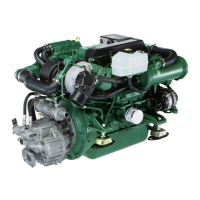54 AB Volvo Penta / Diesel Engine TAMD71B
11.7 Maintenance – Electrical System
NOTE! Always stop the engine and break the current using the main switches before
working on the electrical system.
Also read the section entitled “Electrical system – Important” in chap. 11.5.
11.7.1 Checking batteries and electrical connections
Read the section entitled “Electrical
system – Important” chap. 11.5.
The service life of your batteries depends largely
on how they are maintained. Keep batteries dry
and clean. Dirt on the batteries may cause track-
ing and discharge them, particularly in damp
weather.
Clean the battery terminals and connections us-
ing suitable wire brushes. Poor contact may
cause unnecessary voltage drops.
Fig. 11.4 Cleaning the battery terminals
Tighten the cable terminals well and spray the
battery terminals and connections with anti-cor-
rosive agent or coat them with Vaseline.
Check that the batteries are connected properly.
Also check that all other electrical connections
are dry and free of oxidation and that there are
no loose connections. If necessary, spray these
connections with a water-repellent spray (Volvo
Penta Universal oil).
Charge condition
Check the batteries’ charge condition using a
hydrometer. The battery electrolytic density
should be 1.28 g/cm
3
*. Charge battery if reading
has dropped to 1.24 g/cm
3
* (approx. 75%
charge).
Note. If an aerometer-type hydrometer (see fig-
ure) is used, the value read off applies at a tem-
perature of approx. +25°C (77°F). At other tem-
peratures the reading must be compensated as
follows:
at –20°C (–4°F) compensate by –0.03
at –5°C ( 23 °F) compensate by –0,02
at +10°C (50°F) compensate by –0.01
at +40°C (104°F) compensate by +0.01
Example: A value of 1.24 measured at –5°C
(23°F) should be corrected to 1.22, and means
extra charging is needed.
* Note: For batteries with tropical acid substitute 1.24 g/cm
3
,
and 1.20 g/cm
3
.
Fig. 11.5 Aerometer-type hydrometer
Fig. 11.6 Optical-type hydrometer
Note. An optical-type hydrometer is thermally
compensated.
The various battery cells should display relative-
ly even values. Uneven results may mean that
the battery is more or less ready for replace-
ment.

